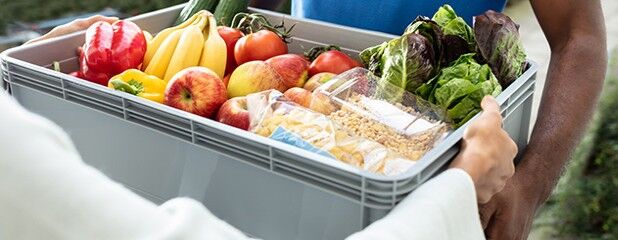A significant amount of grocery retail business today occurs online. Following an initial boom of growth and investment, grocery e-commerce is currently going through a consolidation phase. Providers are competing for profitability; none have been successful for the long-term yet. In late 2022, the quick commerce business Gorillas was bought by its competitor Getir; the quick grocery delivery service Bringmeister recently announced its takeover by the online supermarket Knuspr, and online grocery retailer Oda ceased operations after only a few months. Using examples from the European market, 4flow has identified four important success factors for profitable grocery e-commerce businesses.
1. Breadth and depth of product range determine the top line
To cover high warehousing and logistics costs, businesses depend on high-value orders, which are influenced by the range of products on offer. Online supermarkets like the German grocery retailer Rewe offer a selection of over 15,000 articles. In this case, an average order of €85 is necessary to turn a profit. Quick commerce providers like Gorillas have smaller product ranges of 1,000-2,000 articles and need an average order of only around €40 to cover their costs; the actual average order is around €30. Providers of meal kits like Marley Spoon rely on precise quantities of ingredients for selected recipes and achieve a relatively high order total of €45-50 per kit with a comparatively small product range of around 500 items.
2. The power of cooperation: using partnerships to create sourcing advantages
In contrast to Gorillas or Bringmeister, quick commerce businesses Flink and Picnic ensure favorable purchasing conditions by cooperating with wholesalers, which enables larger gross profits and simplifies the process of expanding product ranges. Meal kit providers are an exception here too. They benefit not only from unprocessed grocery products in sourcing but also from customers who are prepared to pay more for recipe ideas. These conditions enable them to achieve gross profits significantly higher than the industry margin even without partnerships.
3. When it comes to distribution centers, bigger is better
Efficient warehouse organization is also crucial to success: while online supermarkets and meal box providers pick 30-40 order lines per customer, quick-commerce providers only fulfill 8-10 order lines on average – and have higher warehousing costs per order as they depend on manual processes. Online supermarkets benefit from economies of scale and automation when fulfilling around 25,000 orders or more per week. Thanks to central warehouse locations – such as Knuspr in Munich, Rewe in Cologne and Picnic near Düsseldorf, Germany – they achieve costs of €10-15 per order. In quick commerce, small teams and the promised delivery time mean that capacity buffers are required in order picking to cover peaks. This leads to higher picking costs relative to average order values, at €4-6 per order. Meal kit providers benefit from the ability to operate centrally with partial automation and from streamlined incoming orders.
4. Same day, next day or next week?
The speed and frequency of delivery affect delivery costs. The shorter a customer's order horizon is, the fewer deliveries can be consolidated – as a result, more capacity and safety stock are needed to respond flexibly to customer requests. With the milkman principle, pre-defined zones receive deliveries a few times a week. This way, combined with dynamic deliveries in the city, online supermarkets can achieve low delivery costs of €8-9 in both metropolitan and rural areas. Quick commerce companies deliver goods on demand and have significantly higher delivery costs of €5-8 in relation to their revenue. Meal kit providers benefit from their long lead time, which is neither same-day nor next-day, as well as from the lack of deposit processes and from the simple unit of a box for delivery.
Rethinking strategy: the path to profitability
The industry is facing the need to unite profitability and meeting customer demand. Successful businesses are adapting and finding innovative solutions to operate profitably in this dynamic market environment.
Traditional online supermarkets are increasing their profitability through economies of scale; in quick commerce, strategies are being rethought, shopping carts are being increased with delivery fees and minimum order quantities, and the 10-minute delivery promise is becoming more relaxed. Meal-kit providers have the best operating conditions but must continuously invest in innovative recipes and services.
This article was originally published as "E-Food muss Rentabilität und Kundenbedürfnisse vereinen" in the German industry publication Lebensmittelzeitung on page 30 of issue 44, on November 3, 2023.
Sounds interesting? Let's get in touch!
Authors

Nico Brause
Principal
4flow consulting

Hanka Smiejczak
Vice President
4flow consulting

